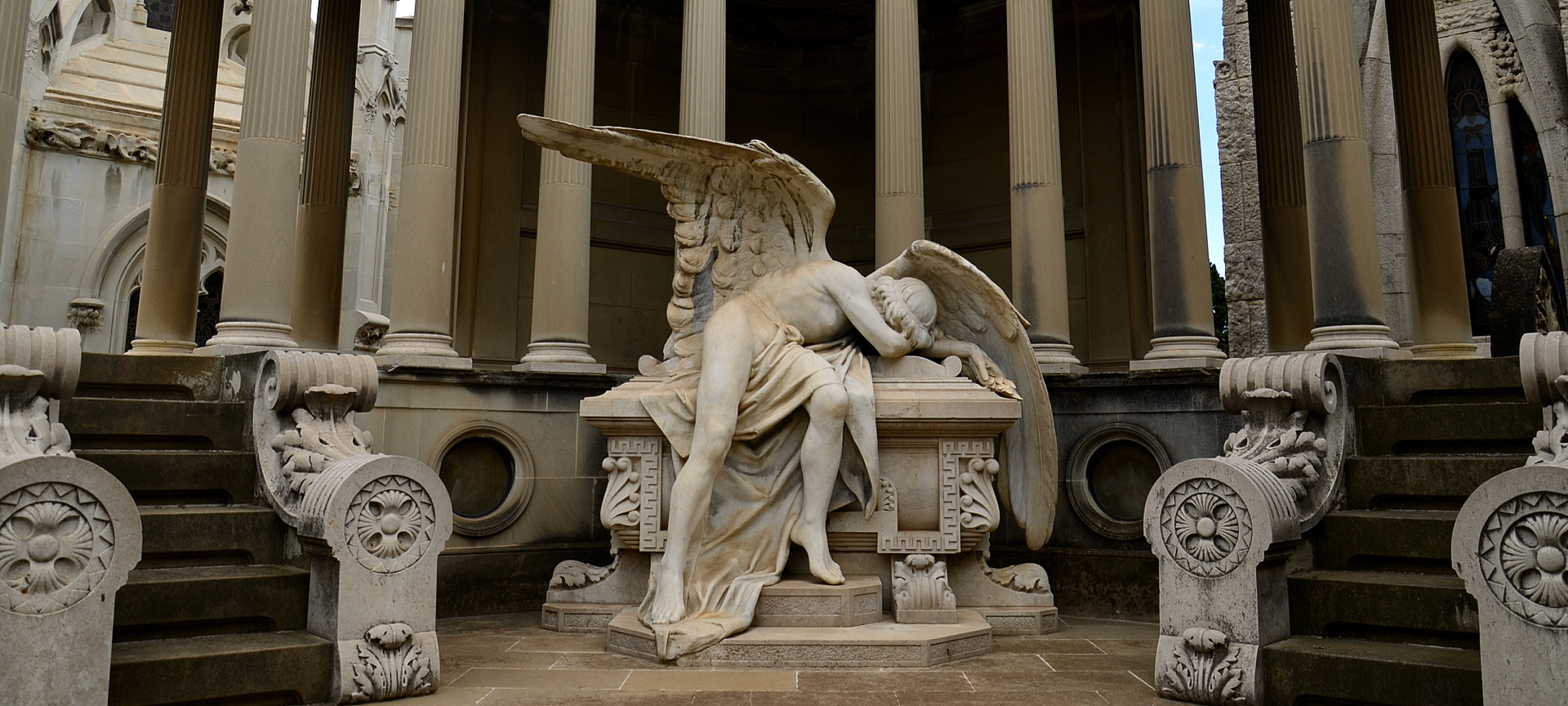
Unique cemeteries in Spain: the art of beyond the grave
Spain has more than twenty exceptional historic cemeteries that are included in the European Cemeteries Route. On this Council of Europe cultural itinerary, together with the tombs of many famous people you’ll also discover some unusual, beautiful and surprising sculptures and funerary monuments. A different sort of art tour for the rather more adventurous. These are the cemeteries included on the route:
-

Galicia, Celtic symbolism overlooking the sea
In this region in the north of Spain there are two exceptional cemeteries. The first one is the case of San Amaro in A Coruña, facing the Atlantic Ocean. It was inaugurated in 1813 and is divided into three areas: The religious, the civil and the British (acquired in 1867 by the British consul in Galicia to bury British citizens who died on Galician lands). On your tour you’ll discover much Celtic symbolism and some wonderful examples of neoclassicism, as well as two memorial monuments and the graves of more than 200 illustrious people. And here's an interesting fact: Here lies Pablo Picasso's little sister. The other cemetery is that of San Froilán in Lugo, very close to the Camino de Santiago. Among the tombs, vaults, and statues in different styles , you’ll find the monument that pays tribute to the soldiers who returned from the war in Cuba in 1898 to die in Galicia.
-
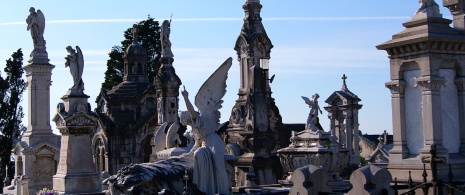
The wealth of the returning Spanish emigrants in Asturias
In the city of Avilés, you can find the La Carriona Municipal Cemetery, opened in 1890. We could say that this is almost an open-air museum that has its own Visitor Centre where guided tours are organised to learn about its artistic value. The wealth of the indianos (those who migrated to the Americas to seek their fortune, later returning to Spain) is reflected in the splendour of their tombs and sculptural monuments, filled with symbols, allegories and medieval inspiration.
-
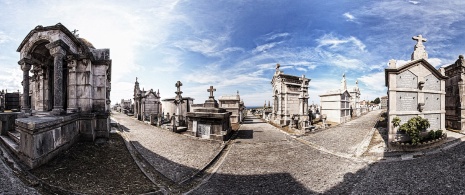
Cantabria: the tomb of the legendary Carmen Amaya
The construction of Ciriego Cemetery in Santander, which many of the region’s best architects and sculptors helped build. Also facing the sea, this beautiful cemetery was opened in 1893, and is a good example of trends in funerary art towards the end of the 19th century. There are different routes to choose from, allowing you to discover the most important sculptures and funerary art work, or the graves of prominent people who are buried there, for example Carmen Amaya, whose remains are interred in the vault of her husband’s family, the Agüeros.
-
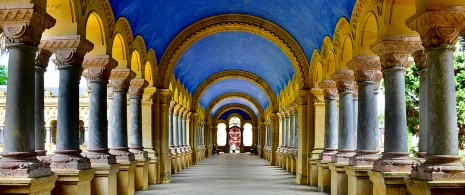
Vaults with a wealth of history in the Basque Country
The monumental entrance to Bilbao Municipal Cemetery, between Derio and Zamudio, already gives a preview of what can be found inside: One of the main funerary art complexes in Spain, with up to 90 pantheons and chapels in modernist or neo-Gothic style, and which has spectacular sculptures and architectural pieces. In Donostia-San Sebastián there is also another historic cemetery worth visiting: the Polloe Cemetery. Built in 1878, this is the most important of the three that are located in the city. The concept of bourgeois hierarchy so typical of the 19th century is reflected in the way the cemetery is set out, with the tombs of the wealthiest and most distinguished families located near the entrance. As well as the great vaults in the classical style created by different artists, you can also see the graves of well-known people such as the painter Ignacio Zuloaga and the politician Clara Campoamor.
-
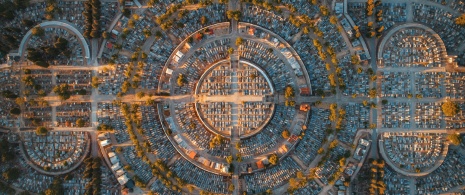
The Almudena cemetery in Madrid
Opened in 1884, La Almudena in Madrid is one of the biggest cemeteries in Europe; it covers an extension of 120 hectares and is the final resting place of around 5 million people. There are several enclosed areas, including a Jewish cemetery. Its many pantheons, chapels and funerary monuments offer artistic examples of very diverse styles: Neo-Gothic, neoclassical, neo-romantic... Many politicians and prominent figures of Spanish culture and society are buried here, such as Lola Flores, Benito Pérez Galdós and Santiago Ramón y Cajal, among others. There are several companies that organise tours so that visitors can discover its secrets.
-
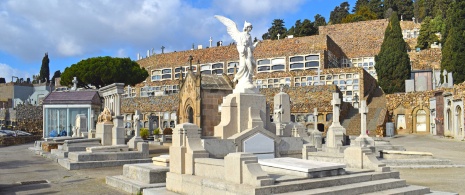
The modernist cemeteries of Catalonia
Catalonia is the region with the highest number of cemeteries included on this unusual European route. There are ten in all, and the modernist style is at their forefront. Many offer guided tours to help you to discover their cultural heritage. Two of them are in the city of Barcelona: Poble Nou Cemetery and Montjuïc Cemetery. At the first, there are many mausoleums and sculptures of great artistic value, although one of the graves most often visited is the niche of the so-called “Santet de Pobelnou”, a young man who died in 1899, and who according to a local legend, grants wishes. At the second you will also find grand mausoleums and the biggest collection of hearses in Europe, as well as the graves of famous artists and composers such as Joan Miró and Isaac Albéniz. And in less than an hour’s drive from Barcelona you can visit other interesting modernist cemeteries such as those of San Sebastián in Sitges, the ones in Arenys de Mar, Vilafranca del Penedés, Igualada and Terrassa , and the Capuchin cemetery in Mataró. In the province of Girona, there is the modernist cemetery ofLloret de Mar, and in Reus, province of Tarragona, you’ll find the first lay cemetery in the country, where a statue of the god Kronos stands guard at the entrance. It dates back to 1870.
-
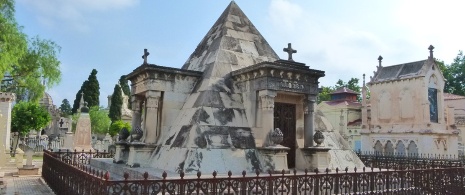
Tours of the “city of the dead” in the Region of Valencia
Among the different styles of the numerous pantheons and mausoleums of the General Cemetery of Valencia, there is one that attracts attention the most: It is the pyramid of the Llovera Family, the only construction with neo-Egyptian forms in the cemetery. Also, the Patio de los Pórticos or of las Columnas, made up of 170 Doric columns built in 1880. To learn more about the history and its funerary heritage, the project Museum of Silence was created, with four different routes. The San Antonio Abad cemetery inAlcoy is also worth a visit. The underground galleries are the only ones of their kind in Spain, and as well as the civil cemetery, there are sections reserved for military and religious burials. The “Alcoy, la ciudad dormida” [Alcoy, the sleeping city] route has great artistic wealth to offer, as well as a good few curiosities.
-
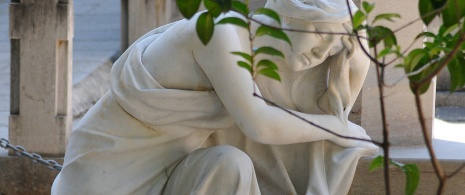
Andalusia: Cemeteries with many surprises
In Andalusia there are four cemeteries that never fail to surprise. In Córdoba you have the cemetery of Nuestra Señora de la Salud, built in 1811 next to the chapel that shares its name, and that some years later was to become the beautiful neoclassical façade of the cemetery itself. This is the final resting place of bullfighters such as Manolete. About 65 kilometres away is the Monturque Cemetery, with an archaeological site inside it declared Property of Cultural Interest. These are Roman cisterns hidden underground for more than a thousand years and which can be visited today. In Granada, the San José municipal cemetery forms part of the monumental surroundings of the Alhambra, very close to the entrance to the Nasrid Palaces. With outstanding examples of Romanesque architecture and funerary sculpture, in the Patio de San Cristóbal the archaeological remains of the Moorish palace of Alixares, dating from the 13th-14th century have been preserved. There are daily guided visits, and in summer and on the eve of All Saints’ Day there are also dramatised visits at night. Malaga is home to the English Cemetery, also known as San Jorge, which is the oldest protestant cemetery in Spain. Created in 1831, here you’ll be able to discover funerary monuments and classical, neo-Gothic and modernist style tombs along with a host of exotic species in the gardens.













